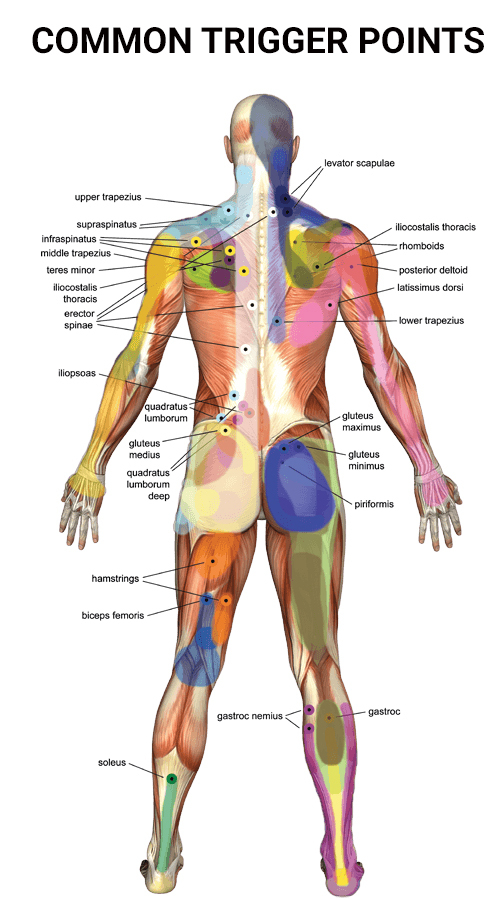Trigger point therapy is also sometimes called myofascial trigger point therapy. Adding to the confusion, there are two different methods to treating trigger points, those are manual trigger point therapy and dry needling. We offer both methods in our facility and each has their own benefits. But before we dive into the different techniques, it’s key to learn what trigger point therapy is.
Myofascial trigger points are painful areas in a muscle. These areas become painful because microscopic changes occur in the muscle fibers which cause them to contract or shorten. Multiple contractions in one region can lead to tightness which can prompt poor circulation, inadequate oxygen to the muscles, less nutrients getting to those areas, and poor healing. It also leads to pain and some restriction of movement.
If someone has myofascial trigger points and they’re experiencing pain or limited range of motion, a release through advanced manual therapy and/or dry needle therapy can help by:
- Improving blood circulation to that zone
- Stretching the taut or tight band of muscles
- Releasing the surrounding tissues
What is Dry Needling Physical Therapy
Dry needling physical therapy is a treatment that uses very thin filiform needles to target those myofascial trigger points, in doing so it relieves pain and can improve movement. Dry needling is not acupuncture.
We mentioned that this type of therapy, trigger point therapy, often goes by different names, the same is true for dry needling, which is sometimes called intramuscular stimulation. No matter what you call it, small needles are inserted into myofascial trigger points, or areas where adhesions have occurred, they stimulate the area which prompts normal blood flow to return to this “starved” region and flush out the area. This helps your muscles relax and fill with blood, oxygen, and nutrients again. It’s the prick of the dry needle that causes your nerve fibers to release endorphins and prompt this response.
One of the most common questions is, does dry needling hurt. This depends on the person because some people are more sensitive than others. The needles are incredibly thin so if you do feel it being inserted, the sensation is often less than that of a pin prick.
To be clear, this needle is going into an area that’s already sore, so you may feel it aggravating that area. You may also experience some muscle twitching as blood is restored to the region, which can feel uncomfortable at the time and leave you with a muscle soreness for several days that feels similar to that of over-exercising. Most people rate the pain as very minimal and more along the lines of discomfort and perhaps a muscle ache for the following day or two. But it’s the resulting absence of pain that makes dry needling so effective. It’s a great way to relieve long-term pain symptoms and restricted range of motion.
So happy to go back running! Thank you for the relief.
MMWe got good stretches in, Thank you till next time.
EQWhat is Manual Trigger Point Physical Therapy
Now that you understand what’s involved in dry needle therapy, it’s easier to understand manual trigger point physical therapy. The best way to think of it is as a trigger point massage. No needles are inserted into those painful myofascial trigger points, instead, targeted massage is used to relieve tight muscles and break up adhesions.
Instead of a traditional massage, this technique targets those specific points and goes to work breaking up the scar tissue. The massage then extends through the muscle and other involved fascia with significant pressure to provide as much release as possible. Many people do report this technique as painful, some call it a good pain.
The main reason to pursue this type of physical therapy is that it’s extremely effective and can relieve pain that’s been an issue for a long time and seemed to have no other cure. It’s also a way to speed up recovery from surgery or an injury and correct muscular imbalances. There are many benefits to be realized through trigger point therapy, most importantly, it can lead to resuming your daily activities and enjoying life more without pain.

Benefits of Trigger Point Therapy
If you’re considering trigger point therapy, the best way to get ahead of chronic pain and disability is to act promptly and begin treatment. The benefits of trigger point therapy are vast and can include:
- Reduced muscle tension
- Improved range of motion
- Improved flexibility
- Reduced or eliminated pain
- Better posture
- No medications (over the counter or prescribed) are necessary
- No side effects, except possible muscle soreness
- Improved blood circulation and delivery of oxygen and nutrients
- Natural endorphin release
One thing that our patients really enjoy about trigger point therapy is not a benefit from the therapy specifically but it’s that the treatments don’t waylay their day. We treat busy patients in the heart of New York City and the Wall Street district. Trigger point therapy can be scheduled over a lunch break and have you back in the office for the second half of the day without any downtime.
Book Your Physical Therapy Appointment Now at Physical Therapists NYC
To recover from your pains faster and to rediscover what it means to have your range of motion returned, connect with Physical Therapists NYC. We’re here to give you a solution to your limitations and bring you long-term pain-free relief with the fastest treatment plan possible. Our trained team of physical therapy experts is led by medical doctors to ensure the best care possible.
Consultation

We specialize in treating busy professionals at Physical Therapists NYC, mainly because we are in the heart of the business district. Our downtown location makes it convenient for people who work in the city and on Wall Street to find the time to be seen for care and to have minimal down time in their day. To better accommodate your schedule, we have early morning and evening hours. It should be noted, those are very popular time slots, so we suggest scheduling today to ensure you get the time you want.
In our office, we feature some of the best state-of-the art diagnostic tools available and a well-appointed, full gym for your workouts and exercises. Having the latest and the best technology leads to a faster recovery with less setbacks along the way. We also put a lot of stock in our physical therapy staff, making sure that we have top-rated therapists who are leaders in their field. Your health care is our priority.
Connect with our office today to schedule a physical therapy appointment and begin living your life to the fullest again.

Dr. Hetarth Kapadia is a licensed physical therapist that has extensive experience working with orthopedic, neurological, and cardiovascular patients, bringing a wealth of knowledge and expertise to the practice.
Dr. Hetarth Kapadia received his Bachelor's degree in physical therapy from S.B.B. College Of Physiotherapy and his Master's degree in Kinesiology from California Baptist University, Riverside, California, with a major in Exercise Science.
Dr. Hetarth is now pursuing his Doctorate in Physical Therapy at Touro College in New York. Before becoming a part of our practice, he worked in New York at various outpatient clinics where he dealt with patients with musculoskeletal and orthopedic disorders.
More about Dr. Kapadia




